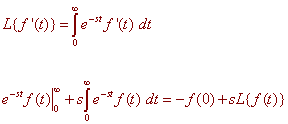Find General Solution Ty00 1 T Y 0 Y 0
Using the Laplace Transform to Solve Initial Value Problems
Now that we know how to find a Laplace transform, it is time to use it to solve differential equations. The key feature of the Laplace transform that makes it a tool for solving differential equations is that the Laplace transform of the derivative of a function is an algebraic expression rather than a differential expression. We have
Theorem: The Laplace Transform of the Derivative
Let f(t) be continuous with f '(t) piecewise continuous. Also suppose that
f(t) < Keat
for some positive K and constant a . Then
L{f '(t)} = sL(f(t)} - f(0)
Proof
To prove this theorem we just use the definition of the Laplace transform and integration by parts. We will prove the theorem for the case where f ' is continuous. If it is piecewise continuous, we can just break the integral into pieces and the proof is similar. We have

For functions f such that f, f ', and f '' satisfy the theorem's conditions we have
L{f ''(t)} = -f '(0) + sL{f '(t)} = -f '(0) + s[-f(0) + sL{f(t)}]
We will be using this often. We rewrite the result as
L{f ''(t)} = s2L{f(t)} - sf(0) - f '(0)
This process will work for higher order derivatives also. With a quick induction argument it can be shown that
L{f (n)(t)} = snL{f(t)} - sn-1f (0) - ... - sf(n-2)(0) - f(n-1)(0)
What this tells us is that if we have a differential equation, then the Laplace transform will turn it into an algebraic equation.
Example
Solve
y'' + y' - 2y = 4 y(0) = 2 y'(0) = 1
Solution
We could solve this problem using the method of undetermined coefficients, however that would involve finding y h , y p , and the two constants. Instead we will see that the method of Laplace Transforms tackles the entire problem with one fell swoop.
We begin by applying the Laplace transform to both sides. By linearity of the Laplace transform, we have
L{y''} + L{y'} - 2L{y} = L{4}
A table of Laplace transforms is useful here. There is on in the textbook or you can find one online here. We get
(s2L{y} - 2s - 1) + (sL{y} - 2) - 2L{y} = 4/s
Next, combine like terms to get
(s2 + s - 2)L{y} = 4/s + 2s + 3
Notice that the coefficient in front of L{y} is the characteristic equation of the differential equation. This is not a coincidence. Putting under a common denominator, dividing and factoring we get
2s2 + 3s + 4
L{y} =
s(s - 1)(s + 2)
To find y, we need to take the Inverse Laplace Transform of the right hand side. Unfortunately, finding a function y such that the right hand side is the Laplace transform of y is not an easy task. The technique that just about always works is partial fractions. We write
2s2 + 3s + 4 A B C = + +
s(s - 1)(s + 2) s s - 1 s + 2
which gives
A(s - 1)(s + 2) + Bs(s + 2) + Cs(s - 1) = 2s2 + 3s + 4
Letting s = 0 gives -2A = 4 A = -2
Letting s = 1 gives 3B = 9 B = 3
Letting s = -2 gives 6C = 6 C = 1
Now we solve
-2 3 1
L{y} = + +
s s - 1 s + 2
or
-2 3 1
y = L-1 + L-1 + L-1
s s - 1 s + 2
Now we can use the table to get
y = -2 + 3et + e-2t
Back to the Power Series Methods and Laplace Transforms Home Page
Back to the Differential Equations Home Page
Back to the Math Department Home Page
e-mail Questions and Suggestions
Find General Solution Ty00 1 T Y 0 Y 0
Source: https://ltcconline.net/greenl/courses/204/PowerLaplace/initialValueProblems.htm